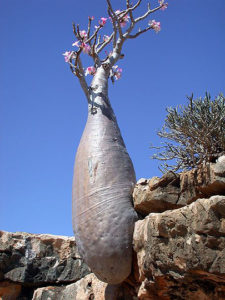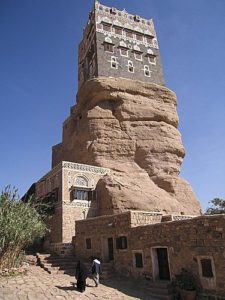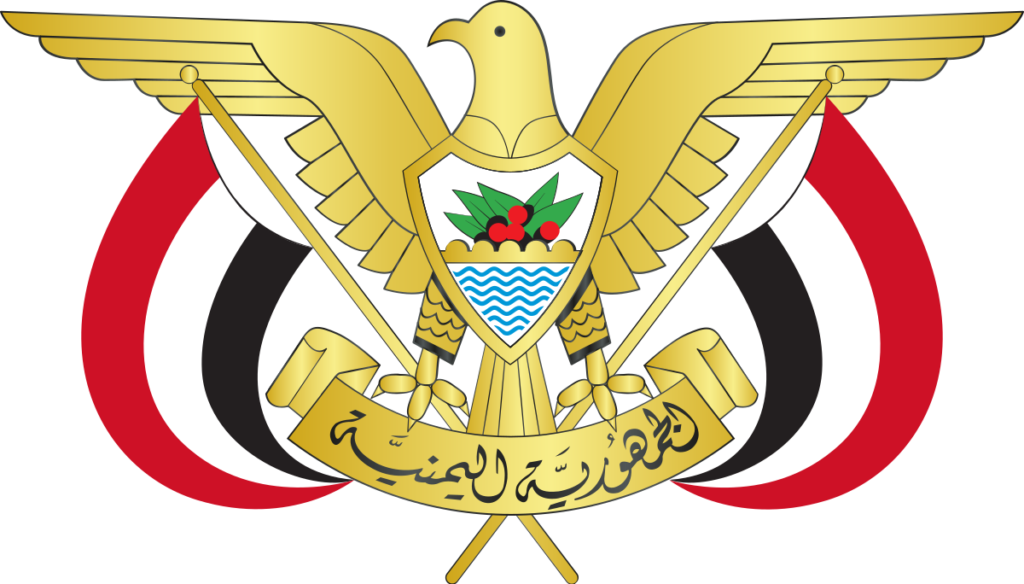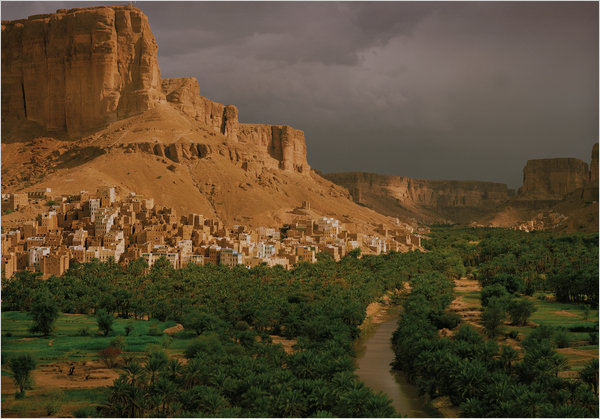The Republic of Yemen is located on the Arabian Peninsula in Southwest Asia . It is bordered on the north by Saudi Arabia, on the south by the Arab Sea and the Gulf of Aden, on the east by the Sultanate of Oman and on the west by the Red Sea.
Official name: Republic of Yemen
City of Sana’a: capital of the Republic of Yemen.
The Republic of Yemen is administratively divided into (20) governorates in addition to the Capital Secretariat.
National flag: It consists of three colors ranked from top to bottom as follows: (Red-White-Black).
The national emblem: The Emblem of Yemen is represented by a falcon, symbolizing the people’s strength and soar in the horizon of freedom, unfolding both wings on the national flag and supported by a base on which the name “The Republic of Yemen” is written with a drawing of Marib Dam and a coffee tree inscribed on it.
Religion and Language: Islam is the religion of the State, and Arabic is the official language.
National Currency: Rial ( Average exchange rate is 199.84 Yemeni rials per US dollar- ( June , 2008)
Universal Timing: GMT +3 hours
Electricity: 220 volts / 50 Hertz
international: country code +967
outlets into and out of Yemen:
Air outlets( Sana’a International Airport – Aden International Airport – Taiz Airport – Alhodeidah Airport – Almukala Airport – Seoun Airport)
Sea Outlets( Aden port – Almakha port – Alhodeidah port – Almukala port – Nashtoon port )
Land Outlets(Haradh Outlet – Albuka’a Outlet – Elbain Outlets – Shahin Outlet – Serfait Outlet- Alwadeah Outlet)
Rule system: rule system is a republican, democratic one with people as the source and owner of the power which they practice directly through referendum and public election. People can also practice power indirectly through the legislative, executive or judicial authorities or through the elected local councils. The political system in the Republic of Yemen is based on multi-party and political. Power-sharing takes place peacefully through the public elections.
President: The President of the Republic of Yemen is the Head of State, to be elected directly by the people in competitive elections with the participation of a number of candidates; victory requires the President to obtain the majority of votes of the electorate. And the presidential term is seven years, commencing from the date takes the oath and A person is not allowed to take office than as President of the Republic for more than two terms.
Local Authority: the Local Authority represents one form of rule practices in Yemen. This process is achieved through rules and constitutional and legal regulations which are based on the principle of financial and administrative decentralization and expanding the opportunities of participating in making policies, plans and programs and taking decisions as well as partnering the society in taking decisions related to running their daily life and improving their living standards. In addition to observing and supervising the performance of administrative agencies in the different governorates and districts. Republic of Yemen is administratively divided, within the Local Authority, into (21) governorates including the Capital Secretariat and Raimah governorate which was recently formed during 2004. The governorates are divided into (333) districts which are branched into (2200) centers and moreover, (36986) villages and ( 91489) localities or neighborhoods The number of local constituencies (5620) local district (polling station).
Population: According to the final results of the general census for the year 2004, the number of population of the Republic of Yemen reached (19.685.161). The population is growing at a rate of (3.0%) per annum, the male population constitute (10.656.919) with the percentage of 50.99% of the total population. The female population constitute (10.244.162) with the percentage of 49.01% of the total opulation:
The total fertility rate is 6.2% birth/ woman
Mortality rate among infants less than a year (77.20) infant per 1000 births
Infant mortality rates 37.3 deaths/1,000 live births
The average Life expectancy at birth : 61.08 years
Average Number of Persons Per family : 7.14 and Average no. of persons per dwelling: 6.9 persons
Terrain:
Yemen is characterized by the diversity of aspects of the surface and therefore has been divided into five major geographic regions :
The coastal plain region : It extends sporadically along the coasts of Yemen, where the mountains and hills cut through it to reach directly to the sea waters in more than one place, therefore, the coastal plain region ofYemen comprises the following plains :
(Tehama Plain- Tuban- Abyan plain-Maifa’a Ahwar plain-the Eastern Coastal plain which lies in Almahrah governorate).
The Coastal Plain region is charac`terized by a hot climate throughout the year with little rainfalls ranging between 50-100 mm per annum . However, it is considered as an important agricultural region, especially Tihama Plain due to the large valleys that penetrate this region, with floods pouring into them thanks to rainfall on the mountainous heights.
The Mountain Highlands Region: This region stretches along the farthest borders of Yemen on the north to the farthest point in the south. This region had undergone many formation movements that resulted in major and minor fractures some of them are parallel with the Red Sea and the other are parallel with Aden Gulf which in turn resulted in the formation of high Plateaus within which some mountainous basins were formed which are called fields or basins.
The region is rich with surface valleys that shape it into sharp sloping block , thus serve as a mountainous wall overlooking Tehama plain with sloping cliffs and peaks. This region’s mountains are the highest ones in the Arabian peninsula. The average Height of which reach 2000m and its peaks reach to more than 3500m. The highest peak reaches 3666m in Alnabi Shuaib Mountain.Water dividing line lies within these mountains where water runs down through many valleys on the east, west and south. Some of these main valleys are Mawr, Haradh, Zabeed, Seham and Raisan valleys whose water all pours in the Red Sea. As for the valleys which pour into Aden Gulf and the Arab Sea, the main ones of which are Wadi Tuban, Wadi Bana and Hadramout Wadi.
The Mountainous Basins Region: This region has mountainous plains and basins located in the Mountain Highlands, mostly located in the eastern section of of the water division line which stretches from the farthest north to the farthest south. The main basins are Yareem,Dhamar, Abar,Sana’a , Amran and Sa’ada basins.
The Plateau Areas Region: It lies to the east and north of the Mountain Highlands and it is parallel to them. But it widens more towards the Empty Quarter and begins a gradual decline.The surface slides toward the north and the east mildly. The majority of the surface of this region is formed from rocky desert surface which is cut through by some valleys especially Hadramout and Hareeb valleys.
Desert Region: It is a sandy region almost devoid of flora except in the areas of rainfall courses where rain runs through after descending from mountainous areas adjacent to this region. Height of the surface ranges between 500-1000m above sea level and it slopes without terrainous discontinuity towards the north east to the center of the Empty Quarter.
Climate here is severe with high temperature , scarce rainfall and low humidity.
Yemeni islands: Many islands spread along the Yemen territorial waters . They have their peculiar terrain, climate and environment. Most of these islands lie in the Red Sea of which the most significant ones are : Kamaran which is the largest inhabited island on the Red Sea as well as Hunnish  Archipelago and Meon island has a strategic location in Bab Almandab strait, the southern gateway of the Red Sea. Some of the main islands on the Arab Sea are Socotra Archipelago. Socotra island is considered as the largest island in this archipelago which, in addition to Socotra Island is comprised of Samhah, Darsah and Abduljori . It is characterized by multitude of its biodiversity sinccce its plants are estimated at 680 species..
Archipelago and Meon island has a strategic location in Bab Almandab strait, the southern gateway of the Red Sea. Some of the main islands on the Arab Sea are Socotra Archipelago. Socotra island is considered as the largest island in this archipelago which, in addition to Socotra Island is comprised of Samhah, Darsah and Abduljori . It is characterized by multitude of its biodiversity sinccce its plants are estimated at 680 species..
Climate: Yemen overlooks two seas, the Red Sea and the Arab Sea. However, Yemen’s climate didn’t benefit a lot from the marine characteristics significantly only in raising the air humidity in the coasts. Influence of these two seas in modifying the republic’s climate features is very limited. Rather it is confined to humidity and modifying the wind features while their effect in the air instability is limited. Rain falls in two seasons. The first season during the spring season (March- April) and the second season in the summer (July- August) during which rains fall greater than the spring season. The amount of rainfall varies greatly from a place to a place. The highest amount of annual rainfall is on the south west highlands as in Ibb, Taiz, Aldhale’a and Yareem. The amount of rainfall ranges between 600-1500m annually. The amount of rainfalls in the western coastal plain become less as in Hodeidah, Mokha, despite the exposure to the monsoon south-west from the Indian Ocean crossing the Red Sea as a result of the absence of a factor raising the wind humid However, the average rainfall annual increases with the altitude of 50 mm on the coast to about 100 0 mm on the slopes of the mountains facing the Red Sea.
The same can be said about the country’s southern and eastern coasts as has been said about the western coasts regarding the rainfall amounts that reach around 50mm per annual as in Aden, Alfayoush, Alkud and Alrayan. This can be attributed to many factors, the main one of which is that the direction of the humid wind movement runs parallel with the coast without penetrating into the internal parts; therefore, the impact would be very small and hence the rainfall are of no economic significance whatsoever.
As for temperature, the eastern and southern plains has such high temperature degrees that it reaches 42°m and goes down to 25°m. Temperature goes down gradually toward higher elevations because of the height factor to reach 33°m as a maximum and 20°m as a minimum. In winter the lesser temperature on the highlands reaches closer to Zero degree and in Dhamar Governorate, in the winter, the temperature -12°m was recorded in 1986.
As for humidity, it is high on the coastal plains up to more than 80% whereas it goes down toward the internal parts where it reaches its minimum rate in the desert areas around 15%.
Tourism: God the Almighty has singled out Yemen with varied terrain depicting a beautiful and comprehensive picture and natural map its visitor including plains, high mountains, basins and fertile valleys as well as hills, highlands, beaches, desert, and climate with diverse coastal , desert and mountainous characteristics. This land and climate diversity led to cultural diversity included the social habits of people ,their clothing, heritage them popular, In addition to the diversity of antiquarian output of each region resulting from the long period of history and civilization down time; This renders Yemen a unique and peculiar country by virtue of the things it possesses more than many countries.
 Tourism in Yemen is a promising sector, since Yemen is the cradle of civilizations and Yemen possesses a variety of varied tourist natural factors of history, ruins, the cultural heritage, and natural fundamentals that make it a tourist landmark. This is evidenced by the diversity of architecture, which makes it provide wonderful architectural models unparalleled in the world. Its possession of a diverse coastal strip is another evidence. There are very magnificent places for recreation and Scuba diving since this beach lies along two seas : the Arab Sea and the Red Sea . Yemen also possesses islands and archipelagos endowed with the nature dazzling features.
Tourism in Yemen is a promising sector, since Yemen is the cradle of civilizations and Yemen possesses a variety of varied tourist natural factors of history, ruins, the cultural heritage, and natural fundamentals that make it a tourist landmark. This is evidenced by the diversity of architecture, which makes it provide wonderful architectural models unparalleled in the world. Its possession of a diverse coastal strip is another evidence. There are very magnificent places for recreation and Scuba diving since this beach lies along two seas : the Arab Sea and the Red Sea . Yemen also possesses islands and archipelagos endowed with the nature dazzling features.
The data available on the tourism sector indicate the existence of expansion in tourist facilities, bringing the number of hotels at the end of the year 2006 to (1166) Hotel, the one-star hotels represent more than 50% of the total number of hotels and the average tourist nights are (6) nights, and the average tourist expenditure per night is (135) dollars as an average.
Health: Development Strategy in Yemen is based on paying attention to the aspects of the provision of the necessary health services to the population, Man is the objective and purpose of development, Therefore, health is one of the areas in which the State seeks to give attention to qualitatively and despite the modest resources available to it, the number of hospitals, including rural hospitals reached (172) Hospital in 2004. The number of physicians reached (5282) ratio of doctors is 1 doctor for every (3734) persons of the population and the number of nurses (8882) nurse at a rate (1.7) per doctor during the same year.

